325th Operations Group
The 325th Operations Group is the flying component of the 325th Fighter Wing, assigned to Air Combat Command of the United States Air Force . The group is stationed at Tyndall Air Force Base, Florida. It conducts training on the Lockheed Martin F-22 Raptor and commands one operational Raptor squadron. It directs the flying and support operations of two F-22 squadrons, a fighter training squadron, an operations support squadron and a training support squadron.
| 325th Operations Group | |
|---|---|
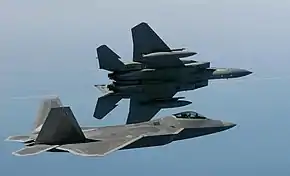 | |
| Active | 1942–1945, 1947–1952, 1955–1960, 1991–present |
| Country | |
| Branch | |
| Role | Fighter |
| Part of | Air Combat Command Ninth Air Force 325th Fighter Wing |
| Garrison/HQ | Tyndall Air Force Base |
| Nickname(s) | Checkertail Clan (World War II)[1] |
| Motto(s) | Locare et Liquidare Latin Locate and Liquidate (1951-present) Consilium Conficitur Plan - Contest (World War II)[1] |
| Engagements | World War II Mediterranean Theater of Operations |
| Decorations | Distinguished Unit Citation Air Force Outstanding Unit Award |
| Insignia | |
| 325th Operations Group emblem[note 2][2] |  |
| 325th Fighter Group emblem (World War II)[1] | 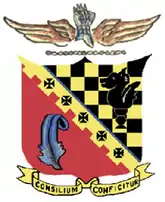 |
The group was first activated in August 1942 as the 325th Fighter Group at Mitchel Field, New York. After training at Hillsgrove Army Air Field, Rhode Island, the group moved to North Africa in 1943, where it flew combat missions with the Curtiss P-40 Warhawk, earning a Distinguished Unit Citation for actions over Sardinia for engaging a superior force of enemy aircraft and destroying more than half of them. The group was withdrawn from combat in the fall of 1943 and re-equipped with the Republic P-47 Thunderbolt. After moving to Italy, the group re-entered combat, earning a second Distinguished Unit Citation in January 1944. The group continued in combat until VE Day, returning to the United States in the fall for inactivation.
The 325th was again activated in 1947 as an all-weather fighter unit, moving late in the year to Hamilton Air Force Base. California. It assumed responsibility for air defense of the northern Pacific coast after moving to Moses Lake Air Force Base, Washington. With the beginning of the Korean War, a number of Air National Guard units were activated, one of which was attached to the group. In December 1951, the group dispatched one of its squadrons to Korea to provide all-weather air defense for the Seoul region. However, Air Defense Command (ADC) was finding that the single group and wing organization did not fit its model of dispersed fighter squadrons. Accordingly, it replaced its fighter wings and groups with regionally oriented defense wings and inactivated the group in February 1952.
In 1955, ADC implemented Project Arrow, which replaced its Air Defense Groups organized in the early 1950s with fighter groups that had been active during World War II. The 325th was activated once again at McChord Air Force Base, Washington to replace the 567th Air Defense Group, whose personnel, equipment and mission it assumed. The following year, the 325th Fighter Wing was again activated, and until 1957 the group was a paper organization, used to staff various wing offices. It was inactivated in 1960, with its sole remaining squadron assigned directly to the 325th Wing.
The 325th remained in inactive status until 1991 when it was again activated as the 325th Operations Group.
Assigned units
The 325th Operations Group commands three flying squadrons and two support squadrons.
- 2d Fighter Training Squadron "American Beagle Squadron"
- The 2d Fighter Training Squadron was reactivated in August 2014 to operate Northrop T-38 Talons and conduct adversary training for F-22 Raptor pilots flying air superiority missions.[3]
- 43d Fighter Squadron "American Hornets" (Diagonals on tails)
- The 43d Fighter Squadron was the first squadron to receive the Lockheed Martin F-22 Raptor and is the only Raptor training squadron.[4]
- 95th Fighter Squadron "Mr. Bones"
- The 95th Fighter Squadron activated in June 2023 as an operational F-35A squadron.[5]
- 325th Training Support Squadron "Black Bears"
- The 325th Training Support Squadron manages training resources and conducts academic and simulator training for F-22 pilots, air battle managers and intelligence officers.[6]
- 325th Operations Support Squadron
- The 325th Operations Support Squadron supports F-35 pilots. The squadron controls all air traffic at Tyndall, manages the airfield complex, and provides weather observation and forecasting. The squadron also provides operations, weapons and tactics, life support and water survival training and scheduling.[7]
History
World War II
.jpg.webp)
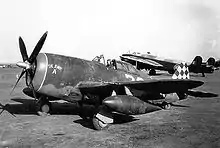

The 325th was first activated as the 325th Fighter Group at Mitchel Field, New York in August 1942 with the 317th,[8] 318th,[9] and 319th Fighter Squadrons[10] assigned. It trained at Hillsgrove Army Air Field with Curtiss P-40 Warhawk aircraft[11] before moving to North Africa by ship and transport planes in January through February 1943. The group entered combat in April 1943 and began escorting medium bombers, flying strafing missions, and conducting sea sweeps from bases in Algeria and Tunisia.[11] The 325th participated in the defeat of Axis forces in Tunisia, the reduction of Pantelleria, and the conquest of Sicily.[11] The 325th received a Distinguished Unit Citation (DUC) for action over Sardinia on 30 July 1943 when the group, using diversionary tactics, forced a superior number of enemy planes into the air and destroyed more than half of them.[11] The group did not fly combat missions from the end of September to mid-December 1943 as the 325th converted to Republic P-47 Thunderbolt aircraft and moved to Italy.[11]
The 325th began operations with Fifteenth Air Force in December 1943, and primarily engaged in bomber escort operations.[11] It received a second DUC for a mission on 30 January 1944 when the group flew more than 300 miles at very low altitude to surprise the enemy fighters that were defending German airfields near Villaorba, Italy; by severely damaging the enemy's force, the 325th enabled heavy bombers to strike vital targets in the area without encountering serious opposition.[11] The group converted to North American P-51 Mustang aircraft in May 1944 and provided the fighter escort on the first shuttle bombing mission from Italy to Russia in early June 1944, and became the first American group to score a victory while flying from a Russian base.[12] It escorted heavy bombers during long-range missions to attack the Messerschmitt factory at Regensburg, the Daimler-Benz tank factory at Berlin, oil refineries at Vienna, and other targets, such as airfields, marshalling yards, and communications targets in Italy, France, Germany, Czechoslovakia, Austria, Hungary, Romania, and Yugoslavia. It also covered operations of reconnaissance aircraft and strafed such targets as trains, vehicles, and airfields. The group continued combat operations until May 1945.[11] The group moved back to the U.S. and was inactivated after V-E Day.[11]
325th Ftr Gp Aerial Victories
| Aerial Victories | Number | Note |
|---|---|---|
| Group Hq | 19 | [13] |
| 317th Fighter Squadron | 209 | [14] |
| 318th Fighter Squadron | 173 | [15] |
| 319th Fighter Squadron | 119 | [16] |
| Group Total | 520 |
Cold War
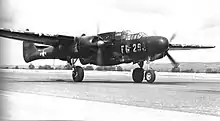
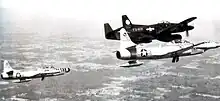
The group was inactive from 1945 until 1947, when it was activated as an all-weather fighter group equipped with Northrop P-61 Black Widows.[11] In 1948, the group converted to North American F-82 Twin Mustang aircraft[11] and moved to Washington, to provide air defense for the Atomic Energy Commission Hanford Plant.[17] In 1948, the US Air Force unified operational and support organizations under a single wing under what is called the Hobson Plan. As a result, the 325th Fighter Wing became the parent for the 325th Group and three other supporting groups[18]
Beginning in Spring 1949, it conducted the All Weather Combat Crew Training School, while participating in air defense operations, exercises and training.[2] In 1951, as ADC expanded its mission, the Federalized 123d Fighter-Interceptor Squadron, flying World War II era F-51Ds, was attached to the group (now named the 325th Fighter-Interceptor Group).[19] Although the 123d received some day fighter North American F-86 Sabres in July, it continued to fly Mustangs while attached to the 325th.[19] Meanwhile, the other three squadrons of the 325th converted from their Twin Mustangs to early model Lockheed F-94 Starfires in June and December 1951.[20]
In December 1951, Fifth Air Force, engaged in the Korean War, indicated to Headquarters, United States Air Force that it needed all-weather interceptors to defend the Seoul area. In response, ADC dispatched the group's 319th Fighter-Interceptor Squadron to Suwon Air Base, although the squadron remained assigned to the 325th group.[21] The 325th group and wing inactivated in February 1952[11] as part of a major Air Defense Command (ADC) reorganization that replaced its fighter wings with regional air defense wings, responding to ADC's difficulty under the existing wing base organizational structure in deploying fighter squadrons to best advantage.[22] Its operational squadrons were transferred to the 4704th Defense Wing at McChord Air Force Base and the 4703d Defense Wing at Larson Air Force Base, Washington.[23]
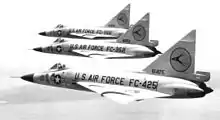
In 1955 the personnel and equipment of the inactivating 567th Air Defense Group,[24] including the 317th Fighter-Interceptor Squadron[8] were transferred to the newly designated 325th Fighter Group (Air Defense),[11] which activated once again at McChord as result of ADC's Project Arrow, which was designed to bring back on the active list the fighter units which had compiled memorable records in the two world wars.[25] Because one purpose of Project Arrow was to reunite fighter squadrons with their traditional groups,[25] the 318th Fighter-Interceptor Squadron was moved from Presque Isle Air Force Base.[9] to assume the personnel and equipment of the 567th's 465th Fighter-Interceptor Squadron.[26] Both of the group's squadrons flew the radar equipped and rocket armed F-86D version of the Sabre.[20] The 325th served as the USAF "host" group at McChord Air Force Base until October 1956, when the 325th Fighter Wing was reactivated[2] and was assigned several support organizations to fulfill its duties.[27][28][29] At the same time it conducted air defense operations.[2]
The group became subordinate to the 325th Fighter Wing again in October 1956 and was non-operational as all group headquarters personnel were used to man the wing headquarters until about June 1957.[2] The squadrons upgraded to Convair F-102 Delta Daggers, the 317th Squadron in December 1956 and the 318th in March 1957.[20] In August 1957, the 317th Squadron moved to Alaska and was reassigned from the group,[8] while the 64th Fighter-Interceptor Squadron simultaneously moved from Alaska to McChord.[30] The group regained control over its tactical squadrons in June 1957 and continued air defense operations of the wing, with annual squadron deployments to Tyndall Air Force Base, Florida for firing practice.[2] Just before the group was discontinued, the 64th Squadron moved to Paine Field, Washington, where it was reassigned to the 326th Fighter Group.[30] The group was in the process of converting to Convair F-106 Delta Darts[20] when it was discontinued in March 1960, with its remaining tactical squadron being transferred directly to 325th Fighter Wing control.[2]
Reactivation
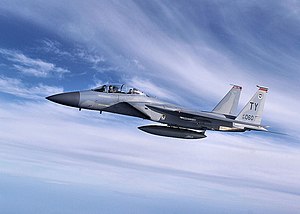
On 1 September 1991, the group was redesignated the 325th Operations Group and activated when the 325th Fighter Wing implemented the USAF Objective Wing organization.[2] The 325th Group was assigned control of the wing's tactical units.[2] The group was originally part of Tactical Air Command, but in an Air Force realignment of advanced crew training responsibilities, it transferred to Air Education and Training Command in June 1992. The group mission was to train McDonnell Douglas F-15 Eagle pilots. It continued this mission until 2010, adding F-22 Raptor training in 2003. When F-15 training ended, the group was reduced to a single flying squadron.[2] The group also conducted battle management training through its 325th Air Control Squadron. This mission ended in October 2012 and transferred to the 33d Operations Group.[31]
In October 2012, the Air Force combined both combat and training F-22 Raptor squadrons into a single group, and realigned the group under Air Combat Command.[32]
Lineage
- Constituted as the 325th Fighter Group on 24 June 1942
- Activated on 3 August 1942
- Inactivated on 28 October 1945
- Redesignated 325th Fighter Group (All Weather) on 2 May 1947
- Activated on 21 May 1947
- Redesignated: 325th Fighter Group, All Weather, on 10 May 1948
- Redesignated: 325th Fighter-All Weather Group on 20 January 1950
- Redesignated: 325th Fighter-Interceptor Group on 1 May 1951
- Inactivated on 6 February 1952
- Redesignated 325th Fighter Group (Air Defense) on 20 June 1955
- Activated on 18 August 1955
- Discontinued on 25 March 1960[note 4]
- Redesignated 325th Tactical Training Group on 31 July 1985 (remained inactive)
- Redesignated 325th Operations Group on 1 September 1991
- Activated on 1 September 1991.[33]
Assignments
|
|
Components
|
Operational Squadrons
|
Support Units
|
Stations
|
|
Aircraft
- P-40 Warhawk, 1942–1943
- P-47 Thunderbolt, 1943–1944)
- P-51D Mustang, 1944–1945, 1951–1952
- P-61 Black Widow, 1947–1948
- F-82 Twin Mustang, 1948–1951
- F-94A Starfire, 1950–1952
- F-86E Sabre, 1951
- F-86D Sabre, 1955–1957
- F-102 Delta Dagger, 1956–1960
- F-106 Delta Dart, 1960
- McDonnell Douglas F-15 Eagle, 1991–2010
- Lockheed Martin F-22 Raptor, 2003 – present[33]
Awards and campaigns
| Award streamer | Award | Dates | Notes |
|---|---|---|---|
| Distinguished Unit Citation | 30 July 1943 | Sardinia, 325th Fighter Group[11] | |
| Distinguished Unit Citation | 30 January 1944 | Italy, 325th Fighter Group[11] | |
| Air Force Outstanding Unit Award | 1 July 1993–30 June 1995 | 355th Operations Group[2] | |
| Air Force Outstanding Unit Award | 1 July 1995–30 June 1996 | 355th Operations Group[2] | |
| Air Force Outstanding Unit Award | 1 July 1996–30 June 1997 | 355th Operations Group[2] | |
| Air Force Outstanding Unit Award | 1 July 1997–30 June 1999 | 355th Operations Group[2] | |
| Air Force Outstanding Unit Award | 1 July 1999–30 June 2001 | 355th Operations Group[2] | |
| Air Force Outstanding Unit Award | 1 July 2001–30 June 2002 | 355th Operations Group[2] | |
| Air Force Outstanding Unit Award | 1 July 2002–30 June 2004 | 355th Operations Group[2] | |
| Air Force Outstanding Unit Award | 1 July 2004–30 June 2005 | 355th Operations Group[2] | |
| Air Force Outstanding Unit Award | 1 July 2005–30 June 2006 | 355th Operations Group[2] | |
| Air Force Outstanding Unit Award | 1 July 2006–30 June 2007 | 355th Operations Group[2] | |
| Air Force Outstanding Unit Award | 1 July 2008–30 June 2009 | 355th Operations Group[2] |
| Campaign Streamer | Campaign | Dates | Notes |
|---|---|---|---|
| American Theater without inscription | 3 August 1942 – 7 February 1946 | 325th Fighter Group | |
| Tunisia | 28 February 1943 – 13 May 1943 | 325th Fighter Group[11] | |
| Sicily | 14 May 1943 – 17 August 1943 | 325th Fighter Group[11] | |
| Naples-Foggia | 18 August 1943 – 21 January 1944 | 325th Fighter Group[11] | |
| Rome-Arno | 22 January 1944 – 9 September 1944 | 325th Fighter Group[11] | |
| Southern France | 15 August 1944 – 14 September 1944 | 325th Fighter Group[11] | |
| North Apennines | 10 September 1944 – 4 April 1945 | 325th Fighter Group[11] | |
| Central Europe | 22 March 1944 – 21 May 1945 | 325th Fighter Group[11] | |
| Po Valley | 3 April 1945 – 8 May 1945 | 325th Fighter Group[11] | |
| Air Combat, EAME Theater | 28 February 1943 – 11 May 1945 | 325th Fighter Group[11] | |
| Normandy | 6 June 1944 – 24 July 1944 | 325th Fighter Group[11] | |
| Northern France | 25 July 1944 – 14 September 1944 | 325th Fighter Group[11] | |
| Rhineland | 15 September 1944 – 21 March 1945 | 325th Fighter Group[11] | |
| Air Offensive, Europe | 28 February 1943 – 5 June 1944 | 325th Fighter Group[11] |
See also
References
Notes
- Explanatory notes
- Aircraft in foreground is Lockheed Martin F/A-22A LRIP Lot 2 Block 10 Raptor 02-2029.
- Approved 1 October 1951.
- Aircraft is P-61B-20-NO Black Widow serial 43-8293 at Hamilton Field
- The group is not related to a 325th Fighter Group (Air Defense), Provisional that was organized at McChord on 1 November 1960 and discontinued on 1 February 1961. see Cornett & Johnson, p. 78.
- Citations
- Watkins, p. 40
- Kane, Robert B. (14 January 2011). "Factsheet 325 Operations Group (AETC)". Air Force Historical Research Agency. Retrieved 23 May 2012.
- Olwell, Chris (21 August 2014). "'Beagles' to be reactivated". Panama City News Herald. Retrieved 30 April 2015.
- "Factsheet 43rd Fighter Squadron". Tyndall AFB Public Affairs. 17 December 2013. Archived from the original on 9 June 2011. Retrieved 29 April 2015.
- Roza, David. "Historic 'Boneheads' Squadron Reactivated at Tyndall, With F-35s Coming in August". Air & Space Forces Magazine. Retrieved 21 June 2023.
- "Factsheet 325th Training Support Squadron". Tyndall AFB Public Affairs. 4 December 2014. Retrieved 29 April 2015.
- "Factsheet 325th Operations Support Squadron". Tyndall AFB Public Affairs. 26 July 2013. Retrieved 29 April 2015.
- Maurer, pp. 386–387
- Maurer, Combat Squadrons, pp. 388-389
- Maurer, Combat Squadrons, pp. 390-391
- Maurer, Combat Units, pp. 206–208
- Abstract, History of 325th Fighter Group, June 1944]. Retrieved 24 May 2012 "Abstract, History 325 Fighter Group Jun 19144". Air Force History Index. Retrieved 24 May 2012.
- Newton & Senning, p. 599
- Newton & Senning, pp. 594-596
- Newton & Senning, pp. 597-598
- Newton & Senning, pp. 598-599
- "Abstract, History 325 Fighter Group(AW) Jul-Dec 1948". Air Force History Index. Retrieved 24 May 2012.
- Ravenstein, p. 10
- Cornett & Johnson, p. 122
- Cornett & Johnson, p. 125
- Endicott, p. 65
- Grant, p. 33
- Cornett & Johnson, p. 66
- Cornett & Johnson, p. 85
- Buss, et al., p.6
- Maurer, Combat Squadrons, pp. 571-572
- Cornett & Johnson, p. 138
- Cornett & Johnson, p. 151
- Abstract, History of 325th USAF Hospital, Jul-Dec 1955 Archived 13 December 2013 at the Wayback Machine. Retrieved 23 May 2012
- Maurer, Combat Squadrons, p. 244
- Elsea, SSG Rachelle (5 September 2012). "325th ACS to remain under AETC". 325th Fighter Wing Public Affairs. Retrieved 3 July 2015.
- Elsea, SSG Rachelle (4 October 2012). "325th FW reassigned to ACC in ceremony". 325th Fighter Wing Public Affairs. Retrieved 1 May 2015.
- Lineage, including assignments, components, stations and aircraft in Kane, AFHRA Factsheet 325 Operations Group, except as noted.
- "Factsheet 1 Fighter Squadron". Air Force Historical Research Agency. 2 January 2008. Retrieved 23 May 2012.
- "Factsheet, 1st Fighter Squadron (Inactivated December 15, 2006)". 325th Fighter Wing Public Affairs. 18 December 2006. Retrieved 1 July 2015.
- Bailey, Carl E. (17 March 2015). "Factsheet 2 Fighter Squadron". Air Force Historical Research Agency. Archived from the original on 7 August 2016. Retrieved 28 April 2015.
- Bailey, Carl E. (16 March 2015). "Factsheet 43 Fighter Squadron (AETC)". Air Force Historical Research Agency. Archived from the original on 4 March 2016. Retrieved 28 April 2015.
- Robertson, Patsy (30 January 2009). "Factsheet 64 Aggressor Squadron (ACC)". Air Force Historical Research Agency. Retrieved 23 May 2012.
- Robertson, Patsy (20 February 2015). "Factsheet 95 Fighter Squadron". Air Force Historical Research Agency. Archived from the original on 4 March 2016. Retrieved 28 April 2015.
- Maurer, Combat Squadrons, pp. 390-391. The online copy includes a handwritten notation of the attachment of the squadron.
- See Mueller, p. 395 for a list of support units activated in August 1955 along with the group.
- Warnock, A. Timothy (7 July 2009). "Factsheet 325 Air Control Squadron (AETC)". Air Force Historical Research Agency. Retrieved 25 May 2012.
- Cornett & Johnson, p. 142
Bibliography
![]() This article incorporates public domain material from the Air Force Historical Research Agency.
This article incorporates public domain material from the Air Force Historical Research Agency.
- Buss, Lydus H.(ed), Sturm, Thomas A., Volan, Denys, and McMullen, Richard F., History of Continental Air Defense Command and Air Defense Command July to December 1955, Directorate of Historical Services, Air Defense Command, Ent AFB, CO, (1956)
- Cornett, Lloyd H; Johnson, Mildred W (1980). A Handbook of Aerospace Defense Organization, 1946–1980 (PDF). Peterson AFB, CO: Office of History, Aerospace Defense Center. Archived from the original (PDF) on 13 February 2016. Retrieved 24 May 2012.
- Endicott, Judy G., ed. (2001). The USAF in Korea, Campaigns, Units and Stations 1950-1953 (PDF). Maxwell AFB, AL: Air Force Historical Research Agency. ISBN 0-16-050901-7.
- Grant, C.L., (1961) The Development of Continental Air Defense to 1 September 1954, USAF Historical Study No. 126
- Maurer, Maurer, ed. (1983) [1961]. Air Force Combat Units of World War II (PDF) (reprint ed.). Washington, DC: Office of Air Force History. ISBN 0-912799-02-1. LCCN 61060979.
- Maurer, Maurer, ed. (1982) [1969]. Combat Squadrons of the Air Force, World War II (PDF) (reprint ed.). Washington, DC: Office of Air Force History. ISBN 0-405-12194-6. LCCN 70605402. OCLC 72556.
- Mueller, Robert (1989). Air Force Bases, Vol. I, Active Air Force Bases Within the United States of America on 17 September 1982 (PDF). Washington, DC: Office of Air Force History. ISBN 0-912799-53-6.
- Newton, Wesley P. Jr. and Senning, Calvin F., (1963) USAF Credits for the Destruction of Enemy Aircraft, World War II, USAF Historical Study No. 85
- Ravenstein, Charles A. (1984). Air Force Combat Wings, Lineage & Honors Histories 1947-1977. Washington, DC: Office of Air Force History. ISBN 0-912799-12-9.
- Watkins, Robert A. (2009). Insignia and Aircraft Markings of the U.S. Army Air Force In World War II. Vol. IV, European-African-Middle Eastern Theater of Operations. Atglen,PA: Shiffer Publishing, Ltd. ISBN 978-0-7643-3401-6.
- Further reading
- Green, Hershel H. (2000). Herky! The Memoirs of a Checkertail Ace. Atglen, PA: Schiffer Publishing, Ltd. ISBN 0-7643-0073-3.
- McDowell, Ernest R. (1994). Checkertails: The 325th Fighter Group in the Second World War. Carrollton, TX: Squadron/Signal Publications, Inc. ISBN 0-89747-316-7.
- McDowell, Ernest R.; Hess, William N. (1969). Checkertail Clan: The 325th Fighter Group in North Africa and Italy. Fallbrook, CA: Aero Publishers, Inc. ISBN 978-0-81689-750-6.
- Rogers, Brian. (2005). United States Air Force Unit Designations Since 1978. Hinkley, UK: Midland Publications. ISBN 1-85780-197-0.
External links
![]() Media related to 325th Fighter Group (United States Army Air Forces) at Wikimedia Commons
Media related to 325th Fighter Group (United States Army Air Forces) at Wikimedia Commons



.svg.png.webp)
.jpg.webp)